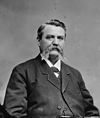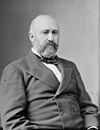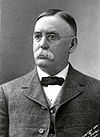
The Territory of Colorado was an organized incorporated territory of the United States that existed from February 28, 1861, until August 1, 1876, when it was admitted to the Union as the State of Colorado.

The Colorado House of Representatives is the lower house of the Colorado General Assembly, the state legislature of the U.S. state of Colorado. The House is composed of 65 members from an equal number of constituent districts, with each district having 75,000 people. Representatives are elected to two-year terms, and are limited to four consecutive terms in office, but can run again after a four-year respite.

The Colorado Senate is the upper house of the Colorado General Assembly, the state legislature of the US state of Colorado. It is composed of 35 members elected from single-member districts, with each district having a population of about 123,000 as of the 2000 census. Senators are elected to four-year terms, and are limited to two consecutive terms in office. Senators who are term-limited become eligible to run again after a one-term respite.
Since Colorado became a U.S. state in 1876, it has sent congressional delegations to the United States Senate and United States House of Representatives. Each state elects two senators to serve for six years, and members of the House to two-year terms. Before becoming a state, the Colorado Territory elected a non-voting delegate at-large to Congress from 1861 to 1876.

These are tables of congressional delegations from Indiana to the United States House of Representatives and the United States Senate.
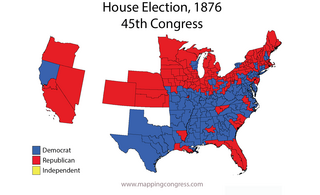
The 1876–77 United States House of Representatives elections were held on various dates in various states between June 5, 1876 and March 13, 1877. Each state set its own date for its elections to the House of Representatives before the first session of the 45th United States Congress convened on October 15, 1877. The size of the House increased to 293 seats with the addition of the new state of Colorado.

The 1796–97 United States House of Representatives elections took place in the various states took place between August 12, 1796, and October 15, 1797. Each state set its own date for its elections to the House of Representatives. The size of the House increased to 106 seats after Tennessee became the 16th state to join the union. The first session of the 5th United States Congress was convened on May 15, 1797, at the proclamation of the new President of the United States, John Adams. Since Kentucky and Tennessee had not yet voted, they were unrepresented until the second session began on November 13, 1797.
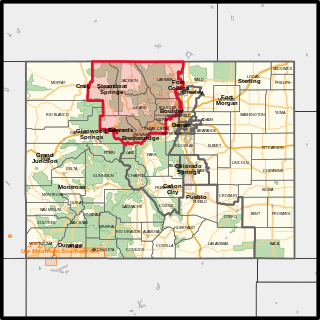
Colorado's 2nd congressional district is a congressional district in the U.S. state of Colorado. The district is located in the north-central part of the state and encompasses the northwestern suburbs of Denver including Boulder and Fort Collins. The district also includes the mountain towns of Vail, Granby, Steamboat Springs, and Idaho Springs. Redistricting in 2011 moved Larimer County, including the cities of Fort Collins and Loveland, to the 2nd from the 4th district. Meanwhile, redistricting in 2021 moved Loveland back to the 4th district and Broomfield and western Jefferson County to the 7th district.

Maryland's 7th congressional district of the United States House of Representatives encompasses almost the entire city of Baltimore and some of Balitmore County. The district was created following the census of 1790, which gave Maryland one additional representative in the House. It was abolished in 1843, but was restored in 1950 as a west Baltimore district. It has been drawn as a majority-African American district since 1973. Democrat Kweisi Mfume is the current representative, winning a special election on April 28, 2020, to finish the term of Elijah Cummings, who died in October 2019. Mfume had previously held the seat from 1987 to 1996.
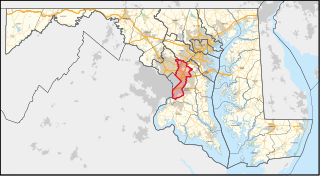
Maryland's 4th congressional district comprises portions of Prince George's County and Montgomery County. The seat is represented by Democrat Glenn Ivey.

William Henry Parker was an American attorney, South Dakota politician, and American Civil War veteran. Parker served as an Assistant United States Attorney for the District of Colorado and was a member of the United States House of Representatives from South Dakota.

Colorado's 5th congressional district is a congressional district in the U.S. state of Colorado. The district lies in the center of the state and comprises Colorado Springs and its suburbs including Cimarron Hills and Fort Carson.

Colorado's 7th congressional district is a congressional district in the U.S. state of Colorado. Formerly located only in the northeast part of the state, the district now encompasses the western parts of the Denver metropolitan area, including Golden, Lakewood, Arvada and Broomfield, along with the central Colorado counties of Jefferson, Park, Teller, Lake, Chaffee, Fremont, and Custer.

Pennsylvania's first congressional district includes all of Bucks County and a sliver of Montgomery County in southeastern Pennsylvania. It has been represented by Brian Fitzpatrick since 2019.
New York's 11th congressional district is a congressional district for the United States House of Representatives in New York City. The 11th district includes all of Staten Island and parts of southern Brooklyn, including the neighborhoods of Bay Ridge, Bath Beach, Dyker Heights, south western Gravesend, western Sheepshead Bay, and parts of southern Bensonhurst. The 11th District is currently represented by Republican Nicole Malliotakis, who is currently, along with George Santos of New York's 3rd district, one of only two Republicans that represent any part of New York City in Congress. Malliotakis was first elected in 2020, defeating one-term incumbent Democrat Max Rose.
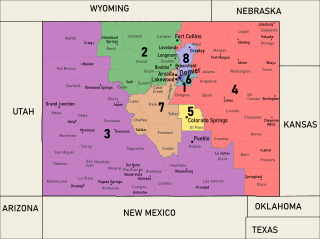
Colorado is divided into eight congressional districts, each represented by a member of the United States House of Representatives.
The State of Colorado was represented in the United States House of Representatives by one member of the House, elected at-large from 1876 until 1893 and from 1903 until 1913, and by two members at-large from 1913 until 1915. Since the 1914 elections, all members from Colorado have been elected from congressional districts.


